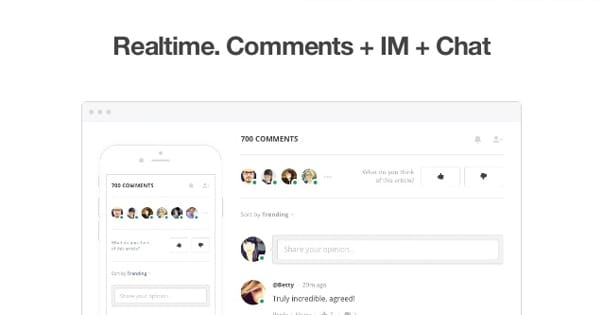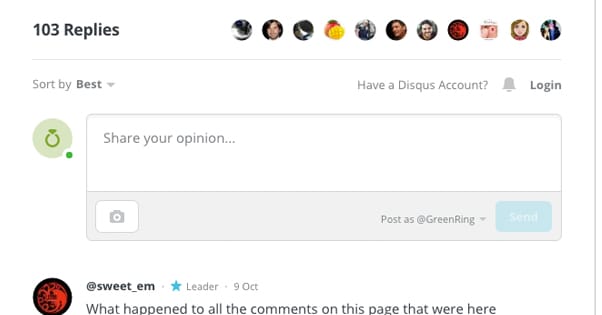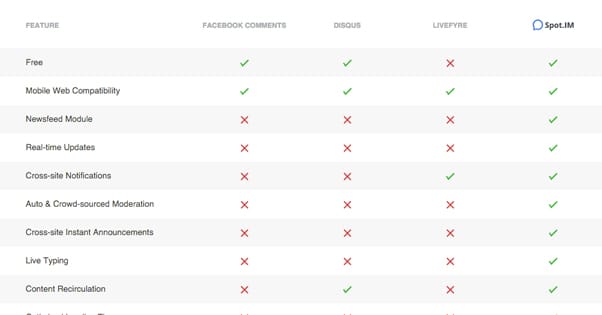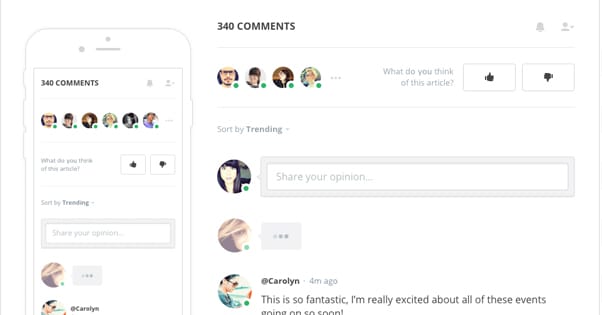Review of Spot.im: A Fast Loading and Clean Comment System
Published by James Parsons • Content Marketing • Posted December 24, 2015 ContentPowered.com
ContentPowered.com
Do you have comments enabled for your blog? You should. Personally, I think they’re great in pretty much every situation. Sure, they take a little upkeep, but what doesn’t? Cutting them off entirely removes a channel of engagement, and engagement is too good to ignore. Blog comments can be some of the best social centers of your community.
If you have comments enabled, what system are you using for them? The default WordPress comments are a good idea in most cases, since they’re familiar, they’re basic, and they’re moderated easily. Then again, maybe you want the greater functionality and off-site login features of Disqus. Or maybe not; some people don’t think Disqus is worth the code it’s written with. Others use Facebook Comments, and that’s fine too. They lead to some funny interactions and some cyclical conversations that quickly get away from your topic, though. On top of that, they can be picky, they don’t always match your blog design, and they occasionally have issues with SEO.
There’s one alternative I haven’t mentioned, that you may not have ever heard of before. It’s called Spot.im, and it has some very interesting features you might be hyped to know about.
Spot.im is not an unknown, and it’s not a startup at risk of disappearing and leaving your comments in a lurch. It was founded by Nadav Shoval and Ishay Green. If those names mean nothing to you, maybe this does; Green created Soluto and won the TechCrunch Disrupt, a huge event about progressive ideas in business and technology.
Spot.im rolled out in a beta back in 2014, starting with around 1,000 sites. It has since grown to be used by a much larger group of sites, though you might not have noticed it if you’re not paying attention. It is, still, relatively young and not as widely adopted as it ought to be. The #1 reason for that is that the comments plugin is not yet SEO friendly – that is, Google can’t read the comments. However, we reached out to them to ask a few questions, and they assured us that not only are they working hard on making their comments system SEO-friendly, they’re planning to have it done within a few weeks of this writing (updated 12/24/2015).
This is because in the next few weeks, they’re rolling out much better WordPress integration, including WP Sync that enabled the import and export of comments to the database. That’s the way Google reads comments, and that makes the plugin SEO friendly.
What Makes Spot.im Unique
So what else does Spot.im have going for it? I wouldn’t be recommending it if it wasn’t going to help your site out, after all.
For one thing, the system dramatically increases engagement by converting your site into a hub for a large real-time social network. Think of it like replacing your blog comments with Facebook’s group chat functionality, rather than comments of any sort. That’s where the .im comes from, in a sense; instant messaging.
By default, Spot.im allows guest contributions, which helps boost engagement quite a bit. While this is prone to abuse, it’s also easily moderated, so you don’t have to worry about guest users spamming your blog comments. Moderation can be done automatically, manually, or in a hybrid setup with blacklisted links, filtered words and spam controls. They also have comment analytics on the way.
It is, of course, compatible with mobile site designs. No good comment system today isn’t, though, so that’s not necessarily a selling point. However, you can customize the way the plugin looks quite a bit, so it’s guaranteed to match your website design.
What makes Spot.im really unique is the way it acts like a cross-site social network. When a user registers, they create a general account for themselves, much like Disqus or any of the other big comment systems. This includes a sort of news feed; any blog the user comments on is added to their feed, so they can see updates either through a central hub or through the comments section on any participating site. This provides real time updates, too; if someone responds to a comment on site A, when the user is browsing site B, they will see the notification and can respond immediately without leaving their current location.
On top of this, it acts very much like an instant messenger. Spot.im has a “live typing” feature, much like instant messengers that notify your message recipient when you’re typing. This is great as an engagement boost. When you leave a comment and you see someone is typing a response, you stick around to see what that response is, you don’t just disappear. This turns single “hit and run” comments into longer, engaged conversations.
To further enhance the social network aspect of the whole thing, users have profile pictures that display in these “group chats” and they have the ability to message one another privately.
In practice, Spot.im isn’t really like Facebook’s messenger or like an instant messenger. It’s actually a lot more like a sort of Twitter feed with an even more real-time, live refreshing setup. You can see it in action on the Entertainment Weekly site, for example. There’s a little blue button on the side of the page that shows when people are typing, and when you click it you’re presented with a news feed that looks a lot like a Twitter/Facebook hybrid feed. It has names, times of responses, messages, and the source article for the comment. It also shows other replies to that comment. You can even see certain commenters highlighted with a blue “influencer” star, a leader star, a contributor star, and more. It’s all very slick and, while robust, it’s also quite unobtrusive.
For all of this complex functionality, you would expect some kind of drawback. Maybe it gets in the way of usability? Nope. Maybe it’s complex to install? Nope, it’s two lines of code, and not in the “we removed all of the line breaks” kind of way. Maybe it’s slow to load? Nope, it’s faster by far than both Disqus and Facebook’s comments.
If there’s any drawback to the plugin, it’s that it isn’t used much more widely than it currently is. Because it becomes an Internet-wide social network, the more sites that use it, the more people will partake. When more sites use it, your site has more visibility through it when people comment, and thus more exposure to a wider audience. In that sense, it’s kind of like Outbrain or other native ads on steroids.
Did I mention that it’s free? As of yet, they’re focusing more on boosting usability and making it the best, most useful comments system it can be, rather than monetizing. Monetization, they say, is going to come in the form of native ads in the news feed; like sponsored stories on Facebook or sponsored Tweets on Twitter. The benefit is, they’ll even add revenue share for publishers.
This is huge. Right now, comments are a bit of a drag, even when they work well. They require resources, time, and attention to manage. They require you to participate. They’re very intensive. They also don’t really get you much in return. Engagement is good, yes, but how often have you heard of someone saying they bought something because of a conversation they had in the comments of a blog post on that site?
Spot.im offers two big benefits to this scenario. First, you can keep track of your own blog comments across several sites all from one place, even if that place is another site that uses Spot.im. Secondly, revenue share monetization is wonderful. It gives comments a tangible benefit on top of their engagement and branding benefits.
Still, this monetization is some ways out. Their first priority right now is to roll out WP Sync, to make the comments more friendly for SEO and accessible to Google. After that, they’re focusing on making the system more engaging, more friendly to new users, and better all around for your site and your KPIs. Only once those are riding high will they implement some form of monetization for themselves and for you.
What’s Old is New Again
If you’ve heard of Spot.im before, and maybe even investigated it months or so ago, one thing you should know is that they’ve changed things up since then. Their new rollout occurred in November of this year, and it kicked off in a major way with their WordPress plugin and some partnerships with big publishers.
Now, one concern is that this system could pull people away from your other forms of social media engagement. I don’t think this is really a problem, though. It’s not like normal blog comments have a big effect on your Twitter engagement one way or another. You’re still going to see Twitter comments on links you post, and you’re still going to see comments on your blog, despite what system you use. The only way this might decrease certain social media engagement is if you were using Facebook comments to boost your Facebook presence, which is inefficient at best. It’s just not, generally, a good means of growing Facebook.
Making Full Use of Spot.im
Making use of Spot.im is very much like encouraging any other form of on-site engagement. You need to go about it the right way to attract and retain commenters.
- You need to do everything you can to encourage engagement. That means simple things like asking for comments and asking questions in your content at the most basic level. It also means creating the sorts of content that gets people talking, either through viral shares, emotional appeal, or news-jacking. It doesn’t matter how you do it; you need to get users to participate in the conversation, with you and with each other.
- Start small and take a personal approach. When your site is small and you only have a few regular commenters, it’s a lot easier to get to know them by name and by what they post. Once you grow beyond a certain level this gets to be a lot harder, but you can still recognize your most common contributors. Spot.im will help with this by branding them with the influencer, contributor, or leader stars based on their contributions.
- Keep an ever-present eye on your comments. With Spot.im it’s pretty easy to do, particularly with cross-site notifications. You’re always around and always available to respond to comments on your page, quickly, like an instant message. This helps keep your audience engaged and in conversation, rather than wandering around elsewhere on the web.
- As you grow, hire a community manager to do that work for you. Make sure you get this person trained in the voice, tone, and stances you want them to convey, in case anything comes up. Make sure they have the power to make things right, in the case of customer service queries, or at least to refer people to the right other people in your organization who can do that for them.
- Make your writing more casual, to appeal to a more casual audience. The more stuffy and formal you are, the less likely people are going to approach you. When you seem untouchable or distant, they figure it’s not very likely that you’re going to pay attention to someone like them, and they won’t bother commenting.
- Use internal links both in your content and your comments to keep people sticking around on your site. This is another thing Spot.im helps with; because there’s a site-wide news feed, any of your content can show up in the feed along with the content the user is commenting on, so activity on a different post will make it available for any fresh commenter to see.
Additionally, you can use live chat through Spot.im as a customer service route. You don’t need to use something like Olark or another live chat system for CS, because you already have Spot.im installed. You can put up a specific article for support, or you can enable comments on articles in your help center. By using these comments as a live chat support stream, you can further encourage users to come to you with their problems. Plus, users can private message you directly through the system, allowing you to respond to more private issues without having to bump a thread publicly in the news feed. This gives two different options within the same system, mimicking the functionality of both comment support, live chat support, and email support all at once.
Overall, there are very few reasons not to adopt Spot.im right now. The number one reason is the lack of SEO support, and that will be changing very soon. If you don’t get many comments, or if you don’t have comments enabled, you lose nothing by turning on Spot.im immediately in preparation for the launch of the new features. It’s only when you have a sizable community already that change can be difficult. In those cases, I might wait long enough to be able to export your current comments and import them into Spot.im, so your community loses nothing and gains a lot of social features.










Hello james, I added this post link as a addition (under Spot.im heading) in my new blog post. I published a list of best comments system for both blogger and WordPress.
So why don’t you guys use Spot.im on your website?